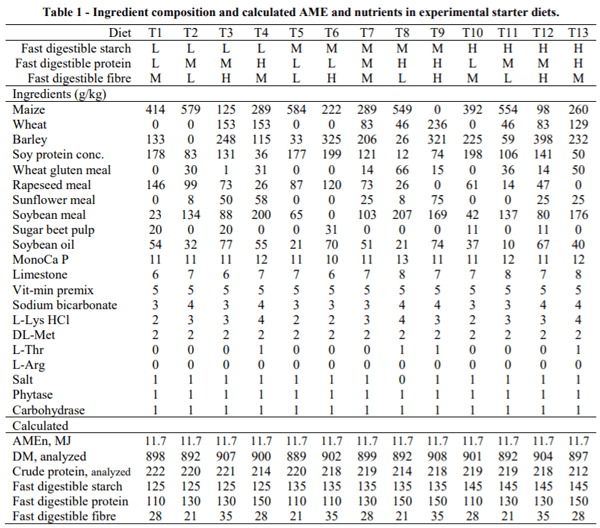I. INTRODUCTION
Improved FCR was observed in broiler chickens fed a slow digestible starch diet compared with a fast digestible starch diet (Weurding et al., 2001). Furthermore, Enting et al. (2005) indicated that a slow digestible starch diet fed to broiler chickens can spare amino acids (AA). Finally, Liu et al. (2017) and Truong et al. (2017) concluded that starch digestion kinetics play a role in broiler performance, but that protein digestion kinetics may be more important than starch digestion kinetics. Taken together, it can be inferred that starch and protein digestion kinetics should be utilized in diet formulation to optimize broiler efficiency. It is also hypothesized that dietary fibre may impact the digestion kinetics of both starch and protein because of its influence on digesta viscosity and passage rate. Therefore, an experiment was conducted to assess the influence of 3 different levels (low, medium, high) and combinations of fast digestible starch, protein, and fibre on broiler growth performance. It can be inferred that a diet formulated to contain a low concentration of fast digestible starch, but a similar concentration of total starch, provided a diet with a greater quantity of slow digestible starch.
II. MATERIALS AND METHODS
a) Experimental Design
A total of 4.800 one-day-old, male Ross 308 broiler chickens were housed in 120 floor pens with 40 birds per pen at the Trouw Nutrition Poultry Research Centre (Casarrubios del Monte, Toledo, Spain). Broilers were randomly allotted to pens that were assigned to 4 experimental blocks placed in 4 equal quadrants of the barn. Twelve experimental diets were formulated to create a response curve, while a thirteenth experimental diet was replicated 6 times within each block to estimate experimental error according to a Box-Behnken design. Diet 13 was the median combination of fast digestible starch, protein, and fibre. This design was replicated 8 times in total, providing 8 replicate pens per each of the 12 dietary treatments and 24 replicate pens per the median dietary treatment.
There were 3 experimental phases; d 0 to 10, 10 to 28, and 28 to 42, the starter, grower, and finisher phases, respectively. Birds and feed remaining in feeders were weighed at the end of each phase and ADFI, ADG, and FCR were calculated.
b) Experimental Diets
The 13 experimental diets were selected to create an optimum response surface to estimate broiler performance for every combination of fast digestible starch, protein, and fibre. The 3 levels were equally spaced in concentrations of fast digestible starch, protein, and fibre to provide a low (L), medium (M), or high (H) concentration of fast digestible starch, protein, and fibre, respectively. The medium level of fast digestible starch, protein, and fibre was determined as the typical level of fast digestible starch, protein, and fibre in commercial broiler diets and the low and high levels were then equally spaced from the medium level.
Experimental diets were formulated to be isocaloric (starter = 11.7 MJ AMEn/kg; grower = 12.0 MJ AMEn/kg; finisher = 12.2 MJ AMEn/kg), isonitrogenous (starter = 220 g/kg CP; grower = 205 g/kg CP; finisher = 190 g/kg), equal in apparent faecal digestible Lys (starter = 11.5 g/kg; grower = 10.6 g/kg; finisher = 9.8 g/kg), Ca and digestible P and met or exceeded current requirement estimates for all other nutrients (Trouw Nutrition Broiler Recommendations, 2011). Starter diets were fed as a crumble, while others were pelleted.
Feed ingredients were selected based on their ability to achieve the desired concentrations of fast digestible starch, protein, and fibre in the experimental diets (Table 1; grower and finisher diets not shown, but ingredient composition was similar to starter diets). The quantities of fast digestible starch and protein in feed ingredients were determined using an in vitro digestion assay adapted from Boisen and Fernández (1997) and Englyst et al. (2000). The quantity of fast digestible fibre was estimated using digestibility coefficients found in literature and adapted from the procedure to fractionate fibre by Jaworski and Stein (2017) after analysis for acid detergent lignin, ADF, NDF, soluble dietary fibre, and insoluble dietary fibre using the Ankom2000 Fiber Analyzer and the AnkomTDF Dietary Fiber Analyzer (Ankom Technologies, Macedon, NY).
c) Statistical Analysis
Data were analyzed using the GLIMMIX procedure of SAS (SAS 9.4, Cary, NC) and effect plots were generated with proc PLM. Response surfaces and subsequent performance optimization were generated with proc RSREG. A probability level of less than 5% was considered significant.
III. RESULTS
Models used showed no lack of fit (P > 0.05). Fast digestible protein had a greater impact on ADFI than fast digestible starch and fibre. On d 10 and 18, an interaction was observed in which increased fast digestible starch and decreased fast digestible fibre increased ADFI, producing an optimum response.
Increased fast digestible protein increased ADG, indicated by the computed fit at the greatest level of fast digestible protein (Figure 1). Increased fast digestible fibre increased ADG, with optimums near the maximum level of fast digestible fibre.
Broiler FCR was improved by increased concentrations of fast digestible fibre, while fast digestible protein had little effect on broiler FCR. The optimum FCR response was determined at a medium level of fast digestible starch.
IV. DISCUSSION
This study was conducted to test the influence of 3 different combinations and levels of fast digestible protein, starch, and fibre based on previous research indicating that the site and rate of starch and protein digestion influences broiler performance (Truong et al., 2017; Moss et al., 2018). We hypothesize that the ‘ileal brake’ theory may be involved in this response because a high concentration of fast digestible starch and protein increased ADFI, suggesting that there was less undigested starch and protein in ileal digesta, therefore, increasing rate of passage and ADFI. This finding suggests that the synchronization of starch and protein digestion kinetics advantage broiler ADFI. However, an optimal FCR was produced with a medium concentration of fast digestible starch. This response is similar to those of Weurding et al. (2001) and Moss et al. (2018) that indicated a high concentration of fast digestible starch depressed protein digestion rates and, therefore, increased broiler ADFI and FCR.
Surprisingly, increased concentrations of fast digestible fibre improved broiler FCR. Rich sources of fast digestible fibre in this study were barley, wheat, soybean meal, and sugar beet pulp. It is hypothesized that rate of passage was reduced and, therefore, digestion dynamics were slowed, favoring greater digestion capacity with increased concentrations of fast digestible fibre. Also, this will increase microbial fermentation and, subsequently, provide the broiler with energy in the form of volatile fatty acids (VFA). Therefore, starch and fibre digestion kinetics may also need to be optimized to provide a correct energy supply between glucose and VFA for both broiler muscle protein synthesis and intestinal function and health.

In conclusion, this study provides further evidence that starch and protein digestion kinetics influence broiler growth performance. Furthermore, dietary fibre and in this case, fast digestible fibre, also play a role in the digestion kinetics of protein and starch as well as energy supply in broiler diets. Results from this study indicate that future research investigating digestion kinetics of protein and starch and the role of dietary fibre in digestion kinetics in broilers is warranted.
Abstract presented at the 30th Annual Australian Poultry Science Symposium 2019. For information on the latest edition and future events, check out https://www.apss2021.com.au/. 












.jpg&w=3840&q=75)